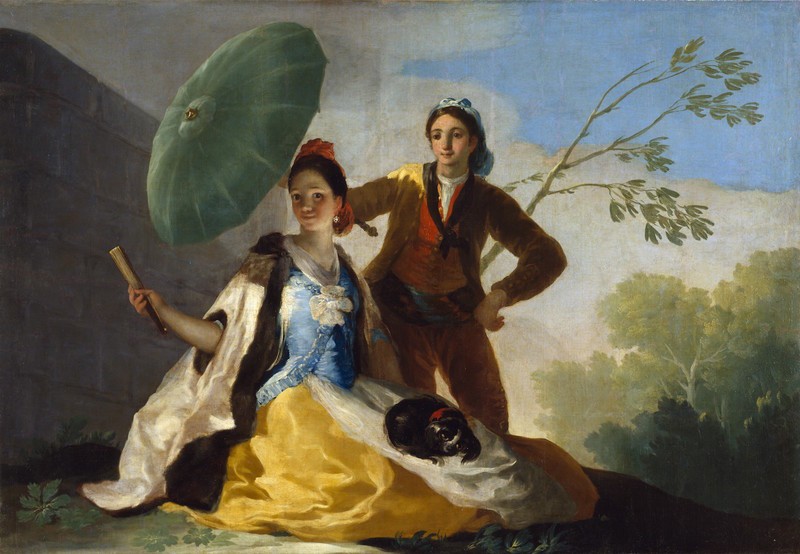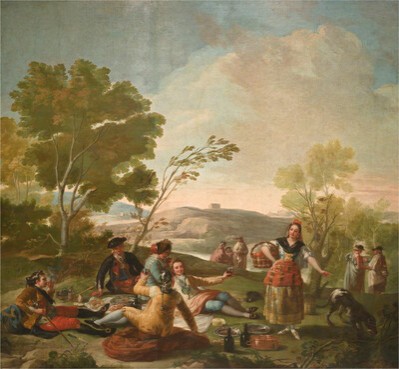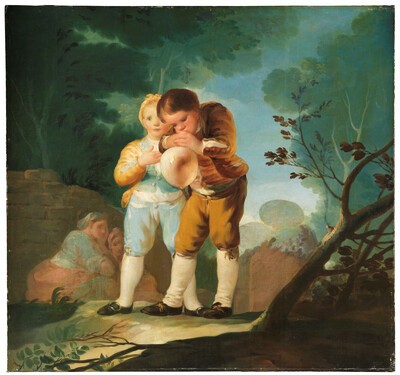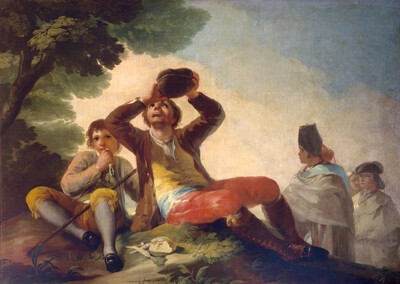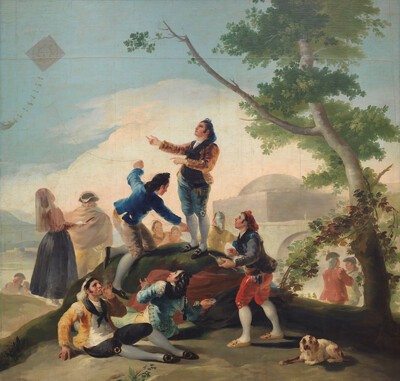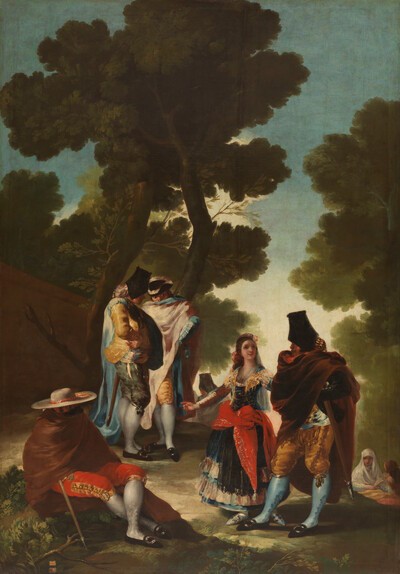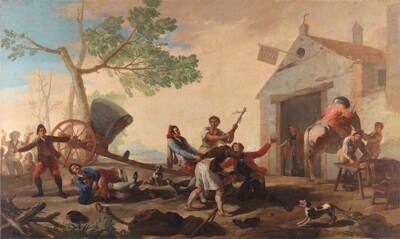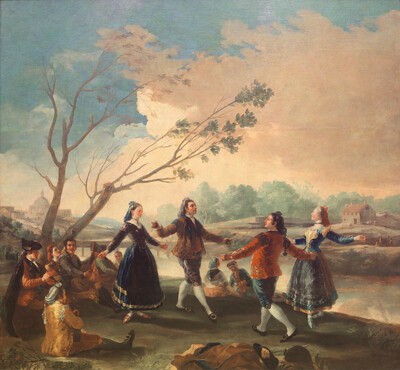- Cronología
- 1777
- Ubicación
- The Prado National Museum. Madrid, Madrid, Spain
- Dimensiones
- 104 x 152 cm
- Técnica y soporte
- Oil on canvas
- Reconocimiento de la autoría de Goya
- Documented work
- Titular
- El Prado National Museum
- Ficha: realización/revisión
- 17 Nov 2009 / 14 Jun 2023
- Inventario
- (P00773)
- Otros títulos:
-
El parasol
La sombrilla
This cartoon formed a pair with The Drinker; the resulting tapestries were designed to be hung over the doors on the east side of the dining room.
The composition of The Parasol is one of the most elegant of all of Goya's works, and one of the most well-known in Spanish painting. It is executed with a low perspective, taking into account its elevated position over the door. The composition has a pyramid-shaped arrangement, responding to the classical influences that Goya learned from Mengs. To give a sensation of depth, the painter arranges the figures into two planes, separated by a mound of earth. The maja sits in the foreground and the ground behind her hides the legs of the majo who is holding the parasol. Both of them are framed by the landscape in the background. This same layout is the one used in the companion cartoon, The Drinker.
The lady is very coquettish, with pale skin and wearing fashionable clothes, far from the gypsy girls and orange-sellers represented by Goya in the other cartoons in the series. Although her gaze is directed at the viewer, her gestures are modest and the fan in her hand is closed to avoid suggesting any intimate messages, whilst her companion protects her from the glare of the sun with the parasol. A small dog is resting curled up in her lap.
This work stands out for its explosion of colours, the contrast between the yellow of the skirt and the blue of the bodice, the bold green of the parasol that is balanced out by the green of the trees on the other side of the composition, and the graduation of the light on the lady's face, filtered through the parasol.
In the words of the American historian Tomlinson, "can we see her [the lady] as anything other than the personification of pride and vanity?". The writer gives the series of cartoons a moralistic interpretation, directly relating them to the seven deadly sins.
The majority of specialists have noted in this work the influence of French painting, comparing it in particular with Vertumnus and Pomona by Jean Ranc (1710-1722, Musée Fabre, Montpellier).
-
De El Greco a GoyaPalacio de Bellas ArtesMexico D.F.1978November-December 1978cat. 3
-
El arte europeo en la corte de España durante el siglo XVIIIGalerie des Beaux-ArtsBurdeos1979Exhibitied also at Grand Palais, París y Museo Nacional del Prado, Madridcat. 13
-
Obras maestras de la pintura española de los siglos XVI al XIXMuseo PushkinMoscow1980Exhibited also at the State Hermitage Museum, San Petersburgocat. 26
-
Von Greco bis GoyaHaus der KunstMunich1982From February 20th to April 25th 1982. Exhibited also at the Künstlerhaus, Vienacat. 16
-
Da El Greco a GoyaFlorence1986cat. 88
-
Goya. 250 AniversarioMuseo Nacional del PradoMadrid1996consultant editor Juan J. Luna. From March 29th to June 2nd 1996cat. 12
-
Tapices y cartones de GoyaPalacio RealMadrid1996organized by Patrimonio Nacional and Sociedad Estatal Goya 96 at the Palacio Real, Madrid, consultant editor Concha Herrero Carretero. May to June 1996cat. 6
-
Francisco de Goya: Maleri, Tegning, GrafikkNasjonalgallerietOslo1996from 10th to April 14th 1996cat. 3
-
Goya. La imagen de la mujerMuseo Nacional del PradoMadrid2001from October 30th 2001 to February 10th 2002. Exhibitied also at the National Gallery of Art, Washington, March 10th to June 2nd 2002, consultant editor Francisco Calvo Serrallercat. 2
-
Goya: Prophet der ModerneAlte NationalgalerieBerlin2005from July 13th to October 3th 2005. Exhibitied also at the Kunsthistorischemuseum, Vienna, October 18th 2005 to January 8th 2006, consultant editor Manuela B. Mena Marquéscat. 3
-
Goya luces y sombrasCaixaForumBarcelona2012consultant editors José Manuel Matilla and Manuela B. Marqués. From March 16th to June 24th 2012cat. 4
-
Goya: Order and disorderMuseum of Fine ArtsBoston2014cat. 57
-
Expérience GoyaLille2021cat. 4
-
L'œuvre peint de Goya. 4 volsParís1928-1950vol. I, p. 65, cat. 6
-
Tapices de GoyaMadridPatrimonio Nacional1946pp. 97, 101, 211, cat. 15 y láms. 68-71
-
Vie et ouvre de Francisco de GoyaParísOffice du livre1970pp. 47 y 86, cat. 80
-
BarcelonaPolígrafa1970vol. I, pp. 245-246, cat. 67
-
L’opera pittorica completa di GoyaMilanRizzoli1974p. 95, cat. 75 y lám. II
-
Francisco de Goya, 4 vols.ZaragozaCaja de Ahorros de Zaragoza, Aragón y Rioja1980-1982p. 87 y p. 117 (il.)
-
Imagen de GoyaMadridLumen1983p. 69
-
Francisco de Goya, cartones y tapicescol. col. "Espasa Arte"Espasa Calpe1987pp. 80, 82, 154, 190, 256, cat. 19C; p.
-
Francisco de Goya. Los cartones para tapices y los comienzos de su carrera en la corte de Madridcol. col. "Ensayos de Arte Cátedra"MadridCátedra1987pp. 70, 72-73, 89 y p. 73 (il.)
-
Goya. 250 AniversarioMadridMuseo del Prado1996pp. 292-293, cat. 12 y pp. 80-81 (ils.)
-
Salas del Palacio Real de El Pardo para las que se tejieron tapices sobre cartones de Francisco de Goya: identificación de las habitaciones y ajuste de las obras de Goya en los alzados de las paredesin HERRERO CARRETERO, Concha (curator, Tapices y cartones de Goya (catalogue of the exhibition organizated at the Palacio Real de Madrid, from may to june 1996)MadridPatrimonio Nacional, Goya 96, Lunwerg1996p. 167 (il.)
-
Goya: Order & DisorderBostonMuseum of Fine Arts Boston Publications2014p. 125
-
Expérience Goya (cat. expo)LilleRéunion des Musées Nationaux2021pp.21-23
